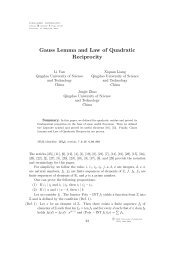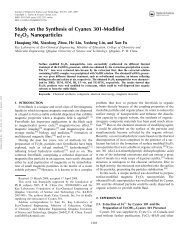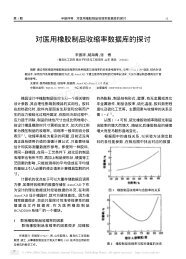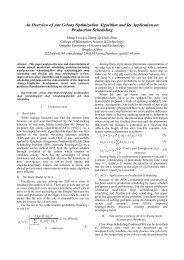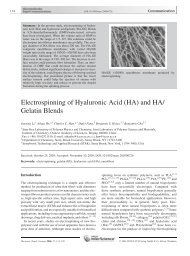Atom transfer radical polymerizations of styrene and butadiene as ...
Atom transfer radical polymerizations of styrene and butadiene as ...
Atom transfer radical polymerizations of styrene and butadiene as ...
Create successful ePaper yourself
Turn your PDF publications into a flip-book with our unique Google optimized e-Paper software.
<strong>Atom</strong> <strong>transfer</strong> <strong>radical</strong> <strong>polymerizations</strong> <strong>of</strong> <strong>styrene</strong> <strong>and</strong> <strong>butadiene</strong> <strong>as</strong> well <strong>as</strong> their copolymerization 45<br />
Fig. 5 Dependences <strong>of</strong> M n , GPC <strong>and</strong> M w /M n on the conversion in the<br />
ATRP <strong>of</strong> <strong>butadiene</strong>.The conditions were the same <strong>as</strong> in Fig. 3. Unfilled<br />
circles, M n ; filled circles, M w /M n ; line, theoretical value M th<br />
(<strong>as</strong>suming “living” conditions)<br />
only a trace amount <strong>of</strong> product, irrespective <strong>of</strong> the reaction<br />
parameters used [22]. At the same time, the polydispersity<br />
<strong>of</strong> the product w<strong>as</strong> around 2.0. In this paper, the conversion<br />
<strong>of</strong> poly<strong>butadiene</strong> reached 23.6% after 15.5 h at 120°C. The<br />
polydispersity <strong>of</strong> this system w<strong>as</strong> lower than 2.0.<br />
The contents <strong>of</strong> cis-1,4-, trans-1,4- <strong>and</strong> 1,2-<strong>butadiene</strong><br />
structural units were 22.1%, 58.4% <strong>and</strong> 19.5%, <strong>as</strong> elucidated<br />
using the FTIR spectrum <strong>of</strong> the poly<strong>butadiene</strong>. These<br />
results were similar to those obtained from 1 H NMR <strong>of</strong> the<br />
PBd (the content <strong>of</strong> 1,4-<strong>butadiene</strong> w<strong>as</strong> 83.1% <strong>and</strong> that <strong>of</strong><br />
1,2-<strong>butadiene</strong> w<strong>as</strong> 16.9%, <strong>as</strong> calculated according to [23]).<br />
The microstructure <strong>of</strong> the PBd obtained here w<strong>as</strong> similar to<br />
that <strong>of</strong> PBd obtained by conventional free <strong>radical</strong> polymerization<br />
[24].<br />
Copolymerization <strong>of</strong> <strong>styrene</strong> <strong>and</strong> <strong>butadiene</strong><br />
It w<strong>as</strong> interesting to investigate whether <strong>styrene</strong> <strong>and</strong><br />
<strong>butadiene</strong> copolymer can be obtained through ATRP<br />
initiated by this novel initiator system, C 6 H 5·CH 2 Cl /<br />
MoCl 3 (OC 8 H 17 ) 2 / PPh 3 . The copolymerization <strong>of</strong> Bd <strong>and</strong><br />
St w<strong>as</strong> studied in this regard.<br />
Table 2 The influence <strong>of</strong> the initiator system on conversion, M n , GPC<br />
<strong>and</strong> M w /M n in the polymerization <strong>of</strong> <strong>butadiene</strong><br />
Conditions C 6 H 5·CH 2 Cl /<br />
MoCl 3 (OC 8 H 17 ) 2 :P(Ph) 3 :<br />
Bd=1:1:3:200<br />
C 6 H 5·CH 2 Cl :<br />
Bd=1:200<br />
Polymerization 15.50 62.27 62.27<br />
time (h)<br />
Conversion (%) 23.60 4.80 4.80<br />
M n ×10 −4 1.24 9.88 8.86<br />
M w /M n 1.75 2.44 2.58<br />
Conditions: [Bd] 0 =2.19 M; T=120°C; solution w<strong>as</strong> toluene<br />
Bd<br />
Fig. 6 Relationship between ln([M 0 ]/[M]) <strong>and</strong> polymerization time<br />
for the copolymerization <strong>of</strong> St <strong>and</strong> Bd in toluene. [St+Bd] 0 =4.69 M;<br />
T=90°C<br />
The kinetics <strong>of</strong> the copolymerization <strong>of</strong> St <strong>and</strong> Bd in<br />
toluene at 90°C, initiated by the C 6 H 5·CH 2 Cl / MoCl 3<br />
(OC 8 H 17 ) 2 / PPh 3 initiator system, are shown in Fig. 6.<br />
The molar ratio <strong>of</strong> C 6 H 5·CH 2 Cl/MoCl 3 (OC 8 H 17 ) 2 /PPh 3 /<br />
(St+Bd) w<strong>as</strong> 1/1/3/200, <strong>and</strong> that <strong>of</strong> St/Bd w<strong>as</strong> 2/1. It w<strong>as</strong><br />
found that a semilogarithmic kinetics plot <strong>of</strong> ln([M 0 ]/[M])<br />
versus time gave a straight line. Figure 7 shows that there<br />
is a linear dependence <strong>of</strong> M n on the monomer conversion<br />
<strong>and</strong> a decre<strong>as</strong>e in M w /M n with monomer conversion.<br />
Figure 7.<br />
The microstructure <strong>of</strong> the copolymer w<strong>as</strong> characterized by<br />
IR, 13 C NMR <strong>and</strong> 1 H NMR. In the IR spectrum <strong>of</strong> the<br />
copolymer (Fig. 8), absorptions at 738, 911 <strong>and</strong> 967 cm −1<br />
were characteristic <strong>of</strong> cis-1,4-, 1,2- <strong>and</strong> trans-1,4 <strong>butadiene</strong><br />
structural units, respectively, <strong>and</strong> the peaks at 3023∼3085 cm −1<br />
were <strong>as</strong>signed to the aromatic C–H stretching <strong>of</strong> <strong>styrene</strong> units<br />
in the copolymer. It w<strong>as</strong> also found that the characteristic<br />
Mn<br />
25000<br />
20000<br />
15000<br />
10000<br />
5000<br />
0<br />
0 10 20 30 40 50 60<br />
Conversion%<br />
Fig. 7 Dependence <strong>of</strong> M n , GPC <strong>and</strong> M w /M n on conversion during the<br />
copolymerization <strong>of</strong> St <strong>and</strong> Bd in toluene. The conditions were the<br />
same <strong>as</strong> in Fig. 1. Squares, M n ; triangles, M w /M n<br />
2.4<br />
2.2<br />
2.0<br />
1.8<br />
1.6<br />
Mw/Mn





